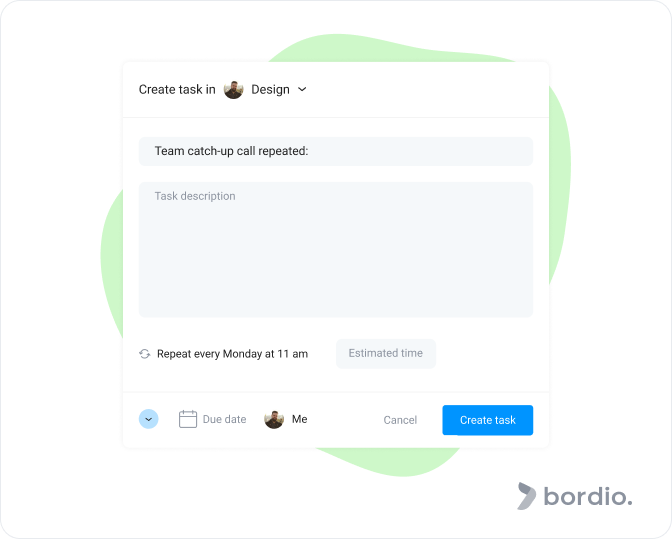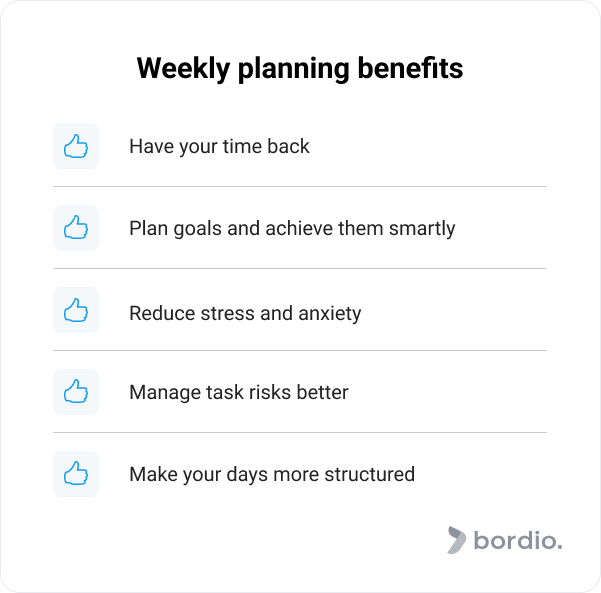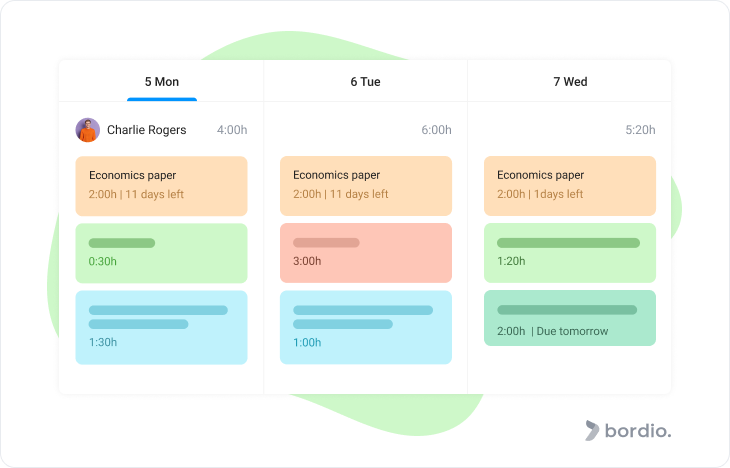At Bordio, we are huge fans of planning. There is so much in life that we want to achieve that planning becomes an integral part of making that happen.
In today’s guide, we want to talk more about weekly planning. We’ll cover why it is important, the role of tools in weekly planning, unfold the common mistakes, and share planner tips that will make this process easier and more fun for you.
Why is weekly planning important
Weekly planning is something we wish everyone would adopt. With today’s crazy life pace, planning your week helps you stay sane, organized, and in tune with your bigger goals.
If you plan your week (for example with online schedule builder), you have a much higher chance of achieving your targets because you will actually do something that brings you closer to them. As a bonus, you’re not going to be as stressed because a plan gives you peace of mind. There’s no need to rush or worry – everything is planned out in schedule maker for free already.
Moreover, planning is good for time management. It can sound counterintuitive, but spending time on creating a structure for your week allows you to save time on execution.
Tips for an effective week planning
Let’s start with the key information – the curated list of actionable planner tips and planner ideas that will help you plan your week ahead to achieve the most while maintaining a healthy work-life balance.
#1 Plan the day before
The first on the list of weekly planner tips is planning the day before.
Yes, you can plan the week on Monday morning. But you are likely to forget something and waste too much time thinking and brainstorming. And instead, you could be dedicating all those hours to going through your weekly tasks and getting ahead. So planning in simple online planner in advance is a great idea.
The start of the day is the most productive time for the majority of people, so don’t miss out on those precious hours doing non-critical work or planning.
#2 Define your goals & priority for the week clearly
Take a minute to think about the next seven days and what you’d like to achieve to move forward in life. Be specific, otherwise, you won’t be as motivated, and it will be impossible to measure your progress.
What type of tasks do you want to work on this week? Put it in your task tracker with the details.
What project would you like to focus on? Set goals for a project in the electronic planner app.
Looking at the entire week instead of working with individual days helps you control the direction of where you’re going. It would be a shame to hustle and work hard day by day, only to look back at the week and see that you’ve not brought yourself closer to where you truly want to be.
#3 Drop down your goals into actionable steps
Create a list of tasks and assign them throughout the week in a logical and subsequent manner. Avoid creating delays caused by dependent tasks being unfinished.
When working through tasks, pay attention to their priority and how long they take to complete. If you have a medium-priority task that takes 30 minutes, you might get it over with before moving on to the top-priority task that you estimate will take 7 hours to complete.
Pro tip: Write down everything in your online to-do list. It’s always with you, so you can keep all tasks in one place. Plus, if you write the task down, you have a record of it, but if you try to remember it – there’s a good chance you’ll forget all about it.
#4 Use the mind sweep technique to get all your to-dos out of your head
The mind sweep technique was initially introduced by David Allen in his best-selling Getting Things Done book. We talk more about Mind Sweep in a separate article, so you can check it out for details.
In short, mind sweeping is the practice where you take a piece of paper or open Bordio and dump all your thoughts, ideas, worries, tasks, and projects. Basically, anything that has a place in your brain and you think about it – must be added to the list. Next, you categorize the list and divide tasks into separate groups (work, personal life, development, physical health, etc). Step three is to work with all tasks, identify their priorities, and start scheduling them into your personal planner. Step four is to start working through your to-do list.
Why is it important? Thoughts and worries take a toll on our mental health. The more things we have on our minds, the less focused we are, and the more energy is drained out of us.
With mind sweeping, you will have a clear understanding of the total scope of work and the importance of its components. You’ll have a structure that will guide you in the right direction and help you maintain a healthy pace as you work on your goals.
Tip: Books like Getting Things Done can be a great source of information and motivation. Check out Bordio’s best productivity books list for more inspiration.
#5 Review your waiting list/backlog every week
If you are a Bordio user, you are familiar with the waiting list – it is a separate list in your weekly or monthly planner where you log all tasks, ideas, and anything else that can’t be scheduled yet but must be remembered for the future. If you have a remote team to manage – you may use a collaborative tools for remote working.
The waiting/backlog list can be any list that you keep in addition to your primary to-dos. The waiting list is a continuation of the Mind Sweep in some way. By maintaining a waiting list (a.k.a. task backlog), you prevent your brain from being overloaded with information.
Yet, if you create a waiting list once and ignore it, the whole purpose of this instrument is defeated. Make it a habit to look through the tasks’ backlog at least once a week and choose what can be scheduled for the current or the upcoming week. Also, as time goes by, your priorities will change. So, if you find that some of the tasks are not relevant anymore – cross them out. We suggest using Bordio’s free time planner for this.
Pro tip: If you haven’t already, consider delegating some of the tasks. Maybe certain things are stuck in your backlog because you simply have no time for them. If that’s the case, find a way to delegate them that works for you.
#6 Use a single planner to store all your tasks & events
There are many great productivity tips out there that help you be more efficient with planning, working, and anything else.
One of the key productivity tips for beginners in planning is to keep a single planner for everything. By “everything” we mean work, personal life, side hustles, meal prep, parenting, and anything else that is a part of your life.
Our energy is not infinite, and so are the hours in our days. Many of us struggle to complete the overly ambitious to-dos, even though they seem rather mild and doable. The reason for failure often lies in ignoring the other parts of our lives. For example, if you are a freelancer and only plan your work tasks (6 hours per day in total), you’d think that it is realistic. However, you might also be a parent who needs to attend to their kids’ needs when they’re not in kinder garden (8 hours a day), and there are chores (3 hours) with a commute (2 hours) that have to be considered too. In total, you can have just 6 hours of work scheduled but over 19 hours busy in the day. You have to allocate time properly and use the best time management tools.
No wonder you are always overwhelmed! Therefore, we recommend you the best digital daily planner Bordio with a user-friendly interface and wide functionality.
#7 Set up recurring tasks
If you plan using Bordio or any other digital weekly planner, make sure you create recurring events for tasks and meetings that happen every week. This will save you tons of time and ensure you don’t double-book yourself because you forgot something.
Consider scheduling recurring tasks for things like grocery shopping and meal planning, along with work tasks.
Tip: If you are a visual person, download one of the printable monthly calendars and mark key recurring tasks there. Hang the calendar on the wall or put it at your desk to peek into it every day and get an extra boost of motivation.
#8 Schedule your to-dos in batches
Task-batching is a powerful productivity technique that can make beginner weekly planners’ lives much easier.
Task batching can be seen in two ways. First, it’s a technique to group together similar tasks that require the same energy. For example, if you have to do research for a project and proofread documentation for the other project – those tasks can be grouped. Or if you have client calls, try scheduling them all for the same day.
Obviously, calling a client and doing research are very different and we approach them in different ways. That’s why focusing on certain types of tasks on a given day can lead to higher-quality output.
Another way to view task batching is by making the most of the day when you have important tasks or events scheduled. For example, you have an important customer meeting on Tuesday at 2 pm in the city center. This can’t be rescheduled or moved, so you need to make the most of the rest of the day.
So, before heading to the meeting, make a stop to get gas at the gas station and buy groceries, so you won’t have to go in the evening during rush hour. You could also schedule something past the meeting, such as a long overdue catch-up with a friend, a doctor’s visit, or a movie date. That way, you didn’t just drive two hours one way to meet the client but managed to do a lot of things that you’d have to do anyway.
#9 Leave the room in your schedule to breath
Avoid planning your week back-to-back. No matter how busy you think you are, schedule short breaks and lunch breaks, and leave room between meetings and tasks.
Why? First of all, planning like this adds unnecessary stress. And there is no reason why you’d want to add stress to your life, right?
Secondly, something always goes wrong – people are late to meetings, your computer crashes, and you have to re-write those last pages of the client proposal, or your kid gets sick, and you have to pick them up from school earlier than anticipated.
Don’t let planning make your life harder. We’re doing it for the exact opposite, after all.
#10 Make changes when necessary
When you’re done planning for the week, the last thing you want is to have to redo it because things have changed. Yet, it’s what likely will happen to you because changes and interruptions are inevitable.
If circumstances change, don’t be stubborn and adapt to the new reality faster for your own benefit. The faster you accept that changes happen and learn to adjust your schedule, the more productive and happy you’ll be in the end.
#11 Don’t forget about daily planning
Your plan for the week is crucial for productive and satisfactory days.
However, it is also important to keep track of each day of the week. Don’t forget to work with your daily planner and cross out the tasks that are assigned to that day. It’s daily planning that will help you determine how you’re doing and if you are on schedule or need to speed up or rearrange something.
#12 Analyze what didn’t happen the previous week
As you plan the upcoming week, look back at the past week and see if any tasks were left unfinished. Review each of them and understand why.
Perhaps there was an external reason that prevented you from completing them, or higher priority and urgent stuff came up. Have an honest look at all those tasks and ask yourself – are they still relevant for me next week? If not, feel free to delete them. If these tasks still matter, schedule them again and consider the issues from the previous week to ensure that this time the tasks get done.
#13 Try the Ivy Lee Method if you have too many tasks
The Ivy Lee Method has an interesting legend about the way it was created. Read about it in our dedicated Ivy Lee guide.
In principle, the method imposes a limit on the daily tasks that you can schedule, prohibiting having more than six tasks on your daily to-do list. Such limitation pushes you to really think and prioritize what’s important, focusing on quality rather than quantity.
Once you know that endless to-dos are not an option for you, you will start making surprising decisions that you wouldn’t anticipate making before.
#14 Plan for tasks to take more time than you think
Most of us are prone to underestimating how much time something will take.
And then we end up stressed because the day has gone and we are still nowhere near a complete to-do list. A lot of the time, it’s not because we’re lazy, slow, or unqualified. It’s more about us incorrectly estimating how much time the work actually requires. So, as you go about planning your week and estimating tasks’ duration, add 20-30% to the time you would otherwise have allocated to do this work.
Don’t worry about efficient scheduling here. Even if you end up completing everything faster, you’ll have time for breaks and incoming urgent requests. And there are always lower priority tasks that you can sort out or, better yet, you can dedicate time to strategic planning, creative work, or something else that gets pushed to the backburner a lot.
#15 Have fun with your planner
If you struggle with building a planning routine, consider planner decorating. Planner stickers (digital or physical) and using more colors can help make the shift in mentality and move planning from the “boring but must do” section to an enjoyable part of your day. Sometimes all we need to turn the situation around is to trick our brains a little.
#16 Find an accountability partner
Friends are looking out for friends. Find a buddy or a workmate who could use a bit more structure in their life just like you. Agree to share your weekly plans and keep each other accountable.
Reach out to each other during the week to ensure you’re both on track. And if you’re close enough, schedule coffee dates to go over your goals. That way, you will keep each other pumped about your plans and also get support and advice through a friendly conversation. And as an extra bonus, you will strengthen your relationship by building this weekly ritual.
The benefits of weekly planning
When you plan smart, you execute better.
Planning often is associated with something lame, mundane, or unnecessary. The most free-spirited of us refuse to plan as it kills creativity and makes life seem like one big to-do list. That’s one way to look at planning.
And here is how we see it.
Weekly planning lets you have your time back
The other approach to planning, and weekly planning in particular, is to see it as a great liberator of our time. These days, there is simply too much to do with too little time to do it. If you want to accomplish more and keep your life balanced and healthy – planning is your main helper.
You unlock smart goal-setting and achieving
Planning your goals and how you want to achieve them will lead to you reaching those goals faster. Goals can be scary and intimidating, but when they are planned out, you are less afraid to start, and your productivity skyrockets.
Stress and anxiety go down
When you have a plan that you follow, you know you’ll be able to accomplish everything and there is no rush, giving you peace of mind. The step-by-step process that you’ve drawn up ensures your goal is attainable, even if it’s challenging, so you don’t have anxiety when you realize your goal planning doesn’t add up.
Risk management gets better too
There are already so many external factors that can disrupt your life and affect your goals. There is no excuse why you won’t prepare for what is in your control. Planning will not eliminate all risks that exist out there but will significantly reduce the number of risks that you will be exposed to.
There’s more structure to your days
Structure, process, routine – whatever you call it, you need it to keep you focused, grounded, and moving forward. A chaotic lifestyle looks good in movies, but in reality, it does more harm than good. Having structure means you can rely on something and still keep going and do your best even if you don’t feel motivation or inspiration.
As James Clear has famously said, “You don’t rise to the level of your goals. You fall to the level of your systems”.
Digital weekly planner to boost your organization skills
Working with your upcoming week’s goals and figuring out the schedule is paramount for building the life you want.
The right tools, such as an online weekly planner by Bordio, can upgrade your experience even further.
With Bordio, you get an online calendar planner with a focus on the week and detailed planning of each day. The solution includes both tasks and events, so you can have a realistic view of your days and adequately estimate your workload.
The waiting list will store all your unscheduled tasks and raw ideas.
The projects section will accommodate your bigger endeavors that don’t fit into a single task.
Creating time blocks for upcoming tasks will ensure you have a few hours reserved to complete the important work and meet the deadline.
All these features and tools make your planning more seamless and create a support system for your weekly planning.
Tip: If you are more of a paper planner person, Bordio created a selection of printable weekly planner templates for you to choose from. You’ll find daily, weekly, and monthly planners or various designs. Pair them with a digital planner for the best results.
Most common mistakes of weekly planning
Now you know all the best tips for beginners that will make you a planning champion. The final stop before we let you go is to a list of typical mistakes that many of us make.
Planning is a skill, and it takes time to master. Avoid the mistakes below for better results:
- Not writing down your weekly to-dos and forgetting them.
- Having your weekly to-dos in different places (calendar & task manager & notes & messengers).
- Planning everything back to back without buffer time for unexpected stuff that will inevitably come up (it always does).
- Thinking that you don’t have enough time for planning. As Brian Tracy says, – every minute you spend in planning saves 10 minutes in execution.
- Planning too little time to work on tasks (it gets better, just try to not be overly optimistic as you’re just starting with planning).
- Scheduling important things for the end of the week or late evenings (by that time, you’ll be drained and likely either fail to complete the task or do it with lower quality than you could).
- Ditching planning after one or two failed attempts (planning takes time to master, so don’t be discouraged if you couldn’t commit to your plans, it’s all part of the learning process).
Planning is something that we learn best by doing it. With time you will understand what works for you best and your planning will improve dramatically. As you are embarking on a planning journey, pair it with building new good habits and building a healthy daily routine that will stimulate you to get better.
Final thoughts on weekly planning
There are many successful people out there who inspire us, yet we can’t seem to understand how they manage to do so many things and still have 24 hours within a day. Because their level of productivity seems unattainable to us, we often resort to saying that they’re simply special and not everyone can be like them.
We strongly disagree.
Successful people are not special in the sense that we think they are. Instead, they are willing to do what most of us don’t – to plan their days and weeks and to stick to those plans.
Important disclaimer: a lot of successful people have the resources to hire help and outsource boring tasks, so they can focus on their vision and projects. And if you can’t afford assistants, nannies, and cooks, there is only so much schedule optimization you can do.
Still, many of us don’t utilize the maximum potential of weekly planning. So, if you are unsure or skeptical, try following our planner tips and planning rigorously for the next few weeks. We don’t know what your results will look like, but we guarantee that you will feel like a superhero.
Everyone’s weekly planning journey will look different, but it’s a journey that will lead you to greatness eventually.
Happy planning!











